Earmarked contributions
Earmarking basics
An earmarked contribution is a contribution which a contributor directs to a clearly identified federal candidate or a candidate’s authorized campaign committee, either orally or in writing, through a conduit or intermediary. Earmarking may be done in the form of a designation, instruction, or encumbrance, and may be direct or indirect, express or implied. The Federal Election Campaign Act (the Act) and Commission regulations require special disclosure of earmarked contributions that are received by candidates and their authorized campaign committees. Conduits and intermediaries are also required to follow special disclosure rules, including those conduits/intermediaries who are not registered committees with the FEC, such as individuals or partnerships.
Earmarked vs. bundled contributions
Note that while earmarked contributions are often referred to as “bundled” contributions, the rules discussed in this article are separate and distinct from the rules that apply to contributions that are bundled by registered lobbyists or lobbyist/registrant PACs (commonly known as “lobbyist bundling”). For more information on the lobbyist bundling rules that apply to certain political committees, see the Commission’s page “Lobbyist bundling disclosure.”
Conduit defined
A conduit or intermediary is anyone the campaign has not authorized to raise funds who receives and forwards an earmarked contribution to the candidate or candidate’s authorized campaign committee. Individuals, political committees (including political party committees and political action committees (PACs)), partnerships, and unregistered organizations (such as unregistered PACs or groups) may serve as conduits for earmarked contributions. (Note that the terms “conduit” and “intermediary” are interchangeable; “conduit” will be used in the remainder of this article.)
Persons who are not considered conduits
Commission regulations specifically exempt certain persons from being considered conduits, including:
- An employee or full-time volunteer working for a candidate committee;
- A fundraising representative conducting joint fundraising in which the candidate is a participant;
- An individual who occupies a significant position in a candidate’s campaign and who is expressly authorized to raise money on behalf of that candidate;
- A committee affiliated with the candidate committee (such as another authorized committee of the same candidate); and
- A commercial fundraising firm (such as a vendor) retained by the candidate committee.
Prohibited conduits
Any person or entity who is prohibited from making a contribution to a federal candidate is also prohibited from serving as a conduit, including the following:
- Corporations;
- Labor organizations;
- Trade associations;
- Incorporated membership organizations;
- Partnerships and limited liability companies (LLCs) that elect corporate tax treatment under Internal Revenue Service (IRS) rules;
- Federal government contractors;
- Foreign nationals; and
- Independent expenditure-only committees (commonly known as “Super PACs”).
While a corporation or labor organization may not serve as a conduit of earmarked contributions, a separate segregated fund (SSF) established by a corporation or labor organization may serve as a conduit, subject to certain rules that are discussed in this article (see section “SSFs that serve as conduits”).
Furthermore, no individual may receive a contribution on behalf of a candidate (as a conduit or otherwise) while acting as the representative of a corporation, labor organization, or any other entity that is prohibited from making contributions.
Handling earmarked contributions
An earmarked contribution always counts against the original contributor’s limit for the recipient candidate. If the conduit exercises any direction or control over the contributor’s choice of recipient candidate, then the contribution will count against the limits of both the original contributor and the conduit. If an unregistered organization or group is acting as a conduit, then that organization should be aware that conduit activity could result in making a contribution by that organization, which may trigger registration requirements for the organization.
Forwarding earmarked contributions to a campaign
Any person who receives a contribution (earmarked or otherwise) for a candidate’s authorized committee must forward that contribution to the recipient campaign committee within 10 calendar days of receiving the contribution.
Transmittal reports to the recipient campaign
When forwarding earmarked contributions to a candidate’s campaign committee, a conduit must include a transmittal report containing certain information, depending on the amount of the contribution.
Contributions exceeding $50
For an earmarked contribution that exceeds $50, the accompanying transmittal report by the conduit must contain the following information:
- The name and mailing address of the original contributor;
- The date the contribution was received by the conduit;
- The amount of the contribution; and
- The election designated by the contributor, if any.
Contributions exceeding $200
For an earmarked contribution that exceeds $200, the accompanying transmittal report by the conduit must contain all of the following information:
- The name and mailing address of the contributor;
- The contributor’s occupation and employer;
- The date the contribution was received by the conduit;
- The amount of the contribution; and
- The election designated by the contributor, if any.
Reporting earmarked contributions
By registered political committee conduits
Any conduit who forwards an earmarked contribution to a candidate committee has special reporting requirements. This section applies to conduits who are registered political committees with the Commission, including SSFs, nonconnected PACs, and political party committees. A political committee that serves as a conduit of an earmarked contribution must disclose the earmarked contribution, regardless of amount, on two separate reports: the committee’s next regularly scheduled FEC report, and the transmittal report that is sent to the recipient candidate’s authorized committee along with the earmarked contribution(s). A political committee’s conduit report will vary depending on whether the earmarked contribution was deposited in the conduit’s bank account or was passed on directly to the campaign in the form of the original contributor’s check. When reporting activity as a conduit, a registered political committee must indicate on its next regularly scheduled FEC report whether the earmarked contribution was:
- Transmitted through the conduit’s account, in which case each contribution must be itemized on the reporting schedules for both receipts and disbursements (Schedules A and B); or
- Transmitted in the form of the original contributor’s check, in which case each earmarked contribution must be reported as a memo entry on Schedules A and B.
The committee must also disclose the following information on its FEC report:
- The name and mailing address of the original contributor and, if the contribution is from an individual and exceeds $200, the contributor’s occupation and employer;
- The amount of the earmarked contribution;
- The date the contribution was received by the conduit;
- The recipient of the contribution, as designated by the contributor;
- The date the contribution was forwarded to the recipient candidate committee; and
- Whether the contribution was passed on in cash, by the contributor’s check, or by the conduit’s check.
Reporting example #1: PAC disclosure of contributions earmarked through the PAC (Form 3X)
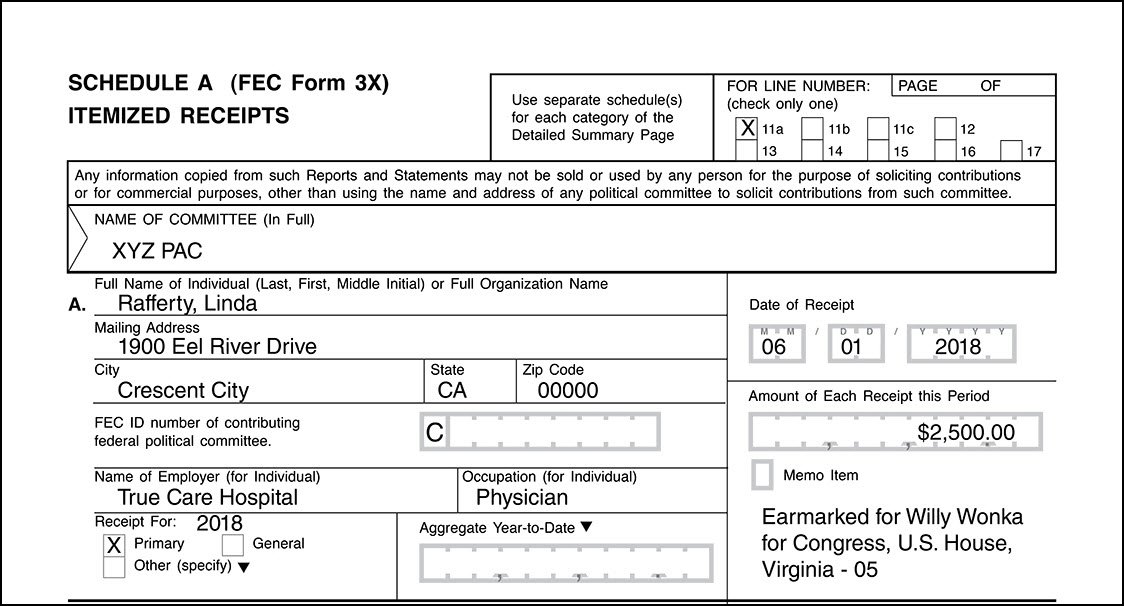
The PAC must report the receipt of the contribution from the individual on their usual FEC report on Form 3X, Schedule A. The PAC must disclose the identification of the contributor, the amount of the contribution, and the date the contribution was received by the PAC. In the memo text field, the PAC discloses the candidate to whom the contribution is directed.
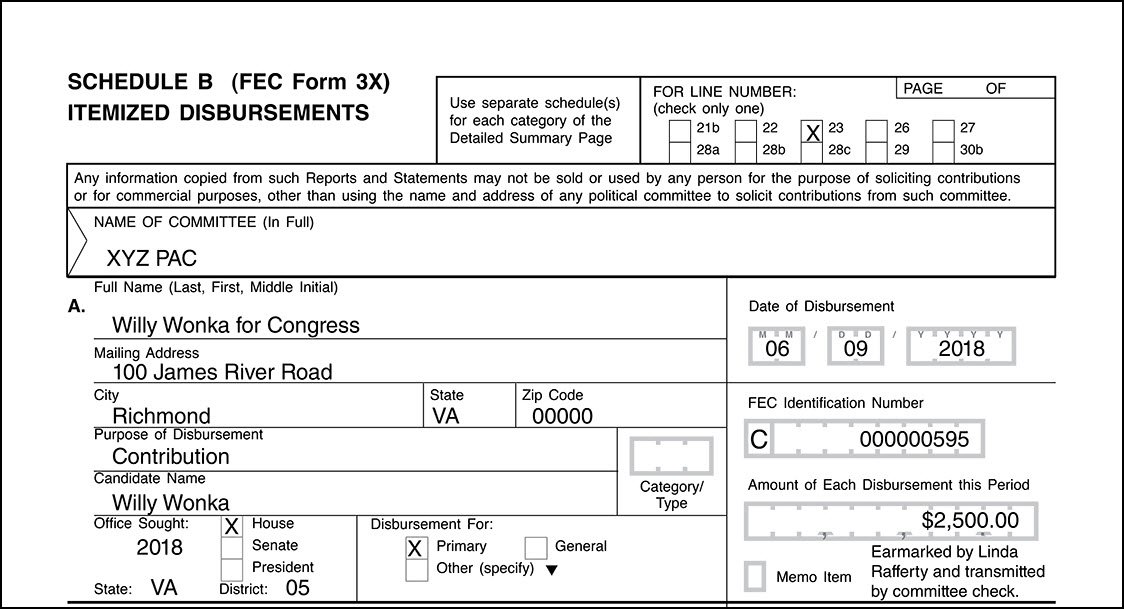
When the PAC forwards the contribution to the recipient candidate (in this case by a PAC check), the PAC must disclose a disbursement on Schedule B to the candidate’s campaign committee with a memo text noting that the contribution was earmarked by the original contributor and transmitted to the candidate committee via PAC check.
By unregistered conduits
A conduit that is not a registered political committee with the Commission (e.g., an individual, partnership, etc.) must, within 30 days of forwarding the earmarked contribution(s) to the recipient candidate’s committee, file a report by letter with the FEC that discloses the following information:
- The name and mailing address of the original contributor and, if the contribution is from an individual and exceeds $200, the contributor’s occupation and employer;
- The amount of the earmarked contribution;
- The date the contribution was received by the conduit;
- The recipient of the contribution, as designated by the contributor;
- The date the contribution was forwarded to the recipient candidate committee; and
- Whether the contribution was passed on in cash, by the contributor’s check, or by the conduit’s check.
Conduit reports by unregistered conduits must be sent directly to the FEC at the following address:
Federal Election Commission
1050 First Street, NE
Washington, DC 20463
Please note that any deliveries of conduit reports made by delivery services such as FedEx, UPS, or DHL should use the same street address above with zip code 20002 instead.
Reporting example #2: Conduit report by an unregistered conduit (e.g., individual, partnership, etc.)
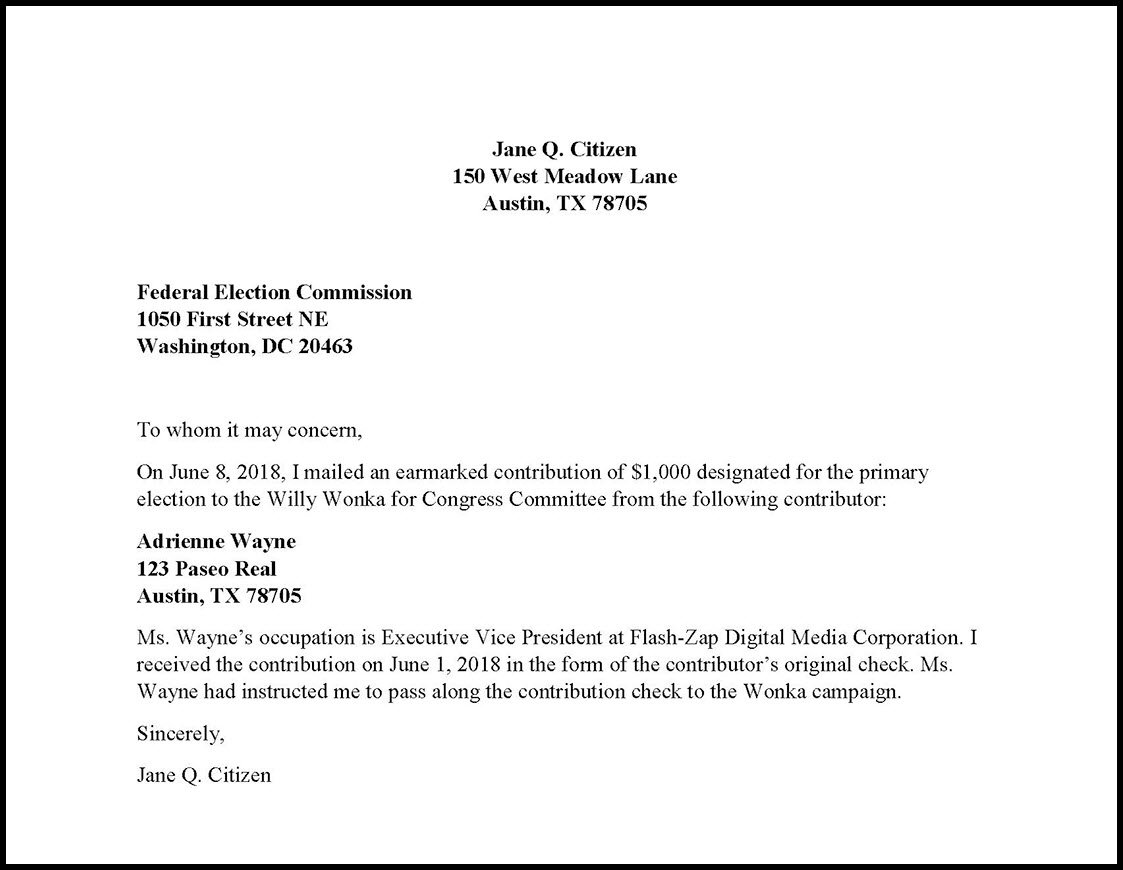
This example notes the individual serving as the conduit who has forwarded the contribution to the candidate’s committee and contains all the relevant information. Conduit reports by unregistered persons must be sent directly to the FEC. Please note that conduit reports received by the FEC are made public.
See the next section for an example of how the candidate committee should report the receipt of this particular earmarked contribution.
By recipient campaign committee
A campaign committee that receives an earmarked contribution must itemize it if the sum total of all earmarked contributions the committee received from a single conduit exceeds $200 in an election cycle. If earmarked contributions require itemization on Schedule A, the committee must disclose the following:
- The name and address of the conduit (and occupation and employer if the conduit is an individual);
- The date of receipt and total amount of earmarked contributions received from that conduit; and
- The original contributions from each individual whose total contributions to the candidate aggregate over $200 in an election cycle (including the full name, mailing address, occupation and employer of the contributor, the amount earmarked and the date the conduit received the contribution.) If applicable, the campaign must also report whether the conduit’s limit was affected (i.e., if the conduit exercised direction or control over the contribution).
If a campaign committee receives an earmarked contribution of $1,000 or more from a conduit between 20 days and 48 hours prior to an election in which the candidate is participating, the committee must file a 48-Hour Notice for this contribution within 48 hour of its receipt from the conduit. For more information about 48-Hour Notice requirements, see the Commission’s webpage on 48-Hour Notices.
Reporting example #3: Reporting contributions received by a candidate committee earmarked through an unregistered conduit (Form 3)
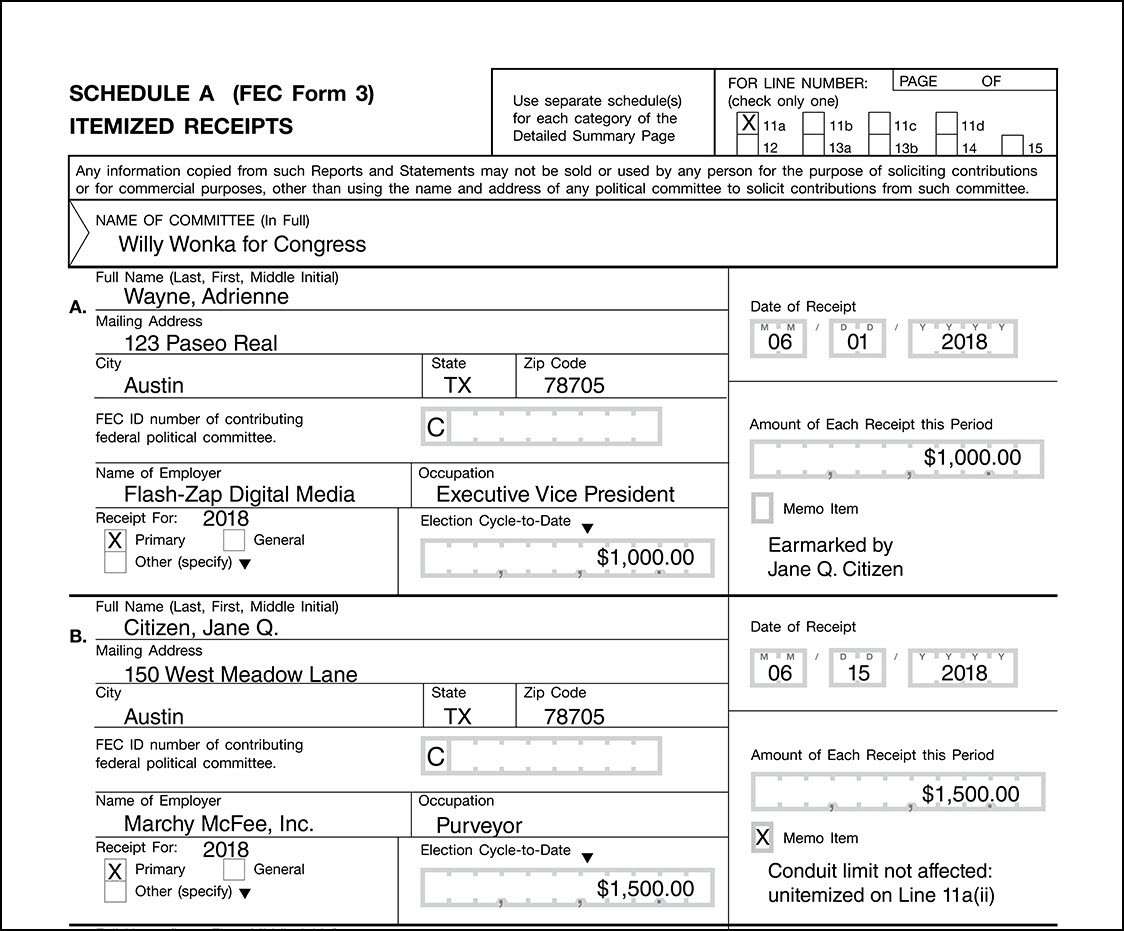
The candidate committee must report the contribution from the original contributor with a memo text that discloses that the contribution was earmarked by a conduit or intermediary (in this example Jane Q. Citizen). The committee must disclose the date of the conduit’s receipt of the contribution from the original contributor in the itemized entry. Additionally, the committee must disclose the conduit as a memo entry along with the total amount of contributions that had been forwarded by the conduit and the date the committee received these contributions from the conduit.
In this example, the conduit Jane Q. Citizen has forwarded Adrienne Wayne’s $1,000 contribution as well as $500 in additional unitemized contributions from others. Since we are assuming that the conduit has not exercised direction or control over the choice of the recipient candidate, we note that the conduit’s (Jane Q. Citizen’s) limit is not affected by her forwarding of these contributions to the campaign.
Reporting example #4: Candidate committee reporting earmarked contributions received from a PAC serving as a conduit (Form 3)
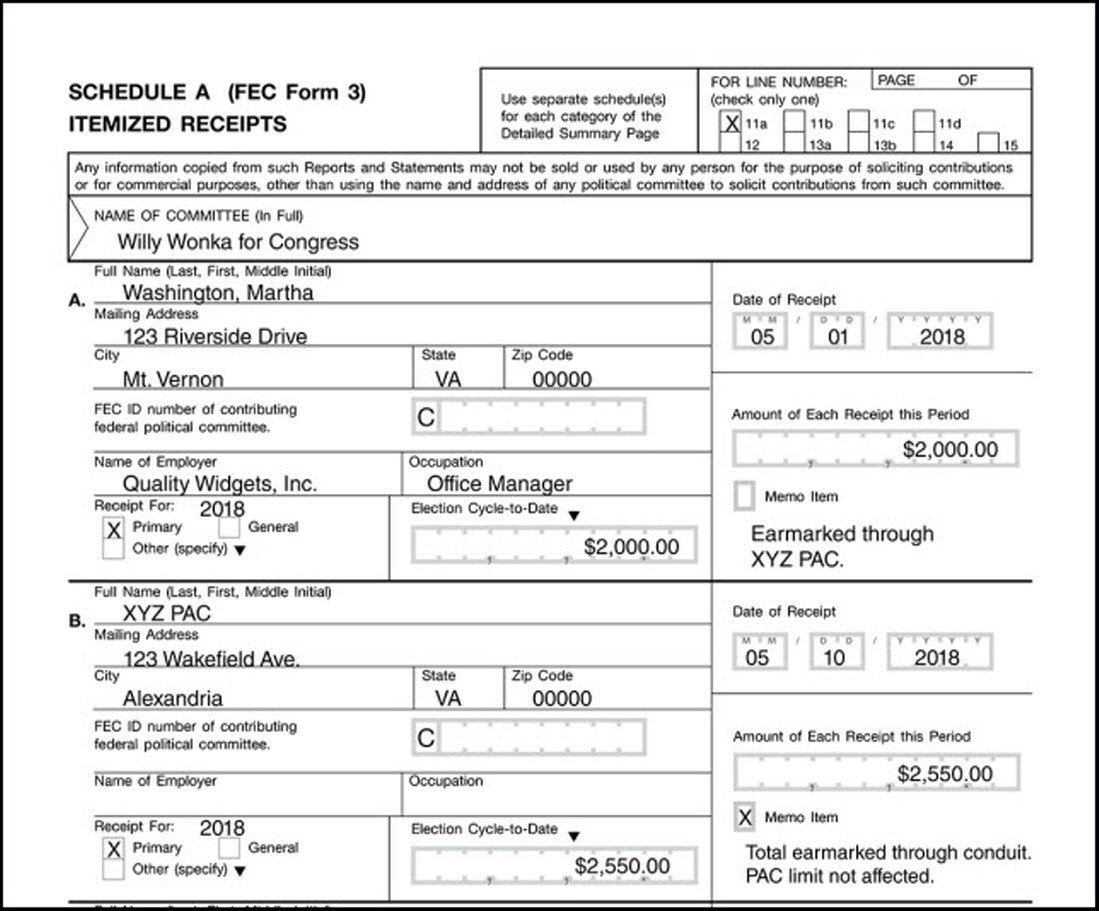
When a candidate committee receives earmarked contributions in the form of a PAC check that is comprised of individual contributions, it must itemize any contributor who has given more than $200 in the election cycle (i.e., as Martha Washington has in this example). Itemized contributions should note the name, address, employer, and occupation of the individual contributor, as well as the amount of the contribution and the date the conduit (XYZ PAC) received the contribution.
The recipient candidate committee should also include a memo entry (Line B above) that discloses the name of the conduit (XYZ PAC here), the total amount forwarded by the PAC, and the candidate committee’s date of receipt of the earmarked contributions from the PAC. In order to clarify that the PAC did not exercise direction or control over the choice of the recipient candidate, the campaign may wish to note in the memo text field that the PAC’s contribution limit to the candidate is not affected.
Special rules for SSFs
While corporations, labor organizations, trade associations, and incorporated membership organizations may never serve as conduits for earmarked contributions, their separate segregated funds (SSFs) may, subject to special rules.
Unsolicited contributions
If an SSF receives and forwards an unsolicited earmarked contribution to a candidate (that is, the contribution was not made in response to an SSF solicitation), the contribution counts only against the original contributor’s limits and does not affect the SSF’s own contribution limit to that candidate. The SSF must still submit a transmittal report to the campaign when forwarding the earmarked contributions and must also disclose the earmarked contributions on its own FEC report, as explained above.
Solicited contributions
If an earmarked contribution was solicited from the SSF’s restricted class by a communication from the SSF’s connected organization (their sponsoring corporation, labor organization, etc.) and was collected and forwarded to the candidate by the SSF, it must be considered a contribution to both the SSF and the candidate, and from both the individual contributor and the SSF. As such, the earmarked contribution counts against several contribution limits. Under these circumstances, the contribution automatically counts against the SSF’s contribution limits regardless of whether the SSF exercised direction or control over the choice of recipient candidate. Again, the SSF must also submit a transmittal report to the candidate’s committee and disclose the earmarked contributions on its own FEC report.
Deferred earmarking through payroll deduction
A member of the restricted class who contributes to an SSF through a payroll deduction program may subsequently earmark those contributions for specific candidates, subject to the requirements outlined. Such a program is sometimes referred to as “deferred earmarking.”
Obtaining designation and forwarding the contribution. The SSF must obtain a signed and dated statement from each contributor designating the particular candidate to receive the contribution, and the amount to be forwarded. Contributors should also designate the election to which they are contributing. While earmarked contributions must normally be forwarded to a candidate within 10 days of receipt, in this instance the SSF must forward the earmarked contributions to the named candidate within 10 days of the designation of the funds by the contributor.
Ledger accounts. The SSF must keep a ledger account of each individual’s payroll deduction contributions. In the case of a program set up for earmarking after the deduction is made, this accounting method assures that the funds will not be used until the contributor designates them for a specific candidate. In one program (AO 1995-15 (Allison Engine PAC)), funds that were left undesignated past the deadline set for designation were available for use by the SSF.
Effect on contribution limits. The committee must consider all funds collected through payroll deduction as contributions to the SSF, regardless of whether contributors later have the option to earmark them for specified candidates. The contributions, once designated for candidates, are viewed as contributions to the candidate and also as contributions made to and by the SSF, and count against all of the applicable limits.
Reporting. The SSF must report receipts from participating employees as contributions to the SSF at the time the SSF receives the deduction proceeds from the employee’s salary or receives the employee’s check. Such contributions must be itemized when the employee’s total for the calendar year exceeds $200. As a conduit of earmarked contributions, the SSF must disclose the conduit transaction in its reports, as explained.
Citations
Statutes
52 U.S.C. § 30102(b)
Account of contributions; segregated funds
52 U.S.C. § 30116(a)(8)
Earmarked contributions
Regulations
11 CFR 102.8(a)
Receipt of contributions
11 CFR 102.15
Commingled funds
11 CFR 110.6
Earmarked contributions
11 CFR 114.2(f)(2)(iii)
Facilitating the making of contributions; earmarking by SSF treated as contributions
11 CFR 114.2(f)(4)(iii)
Permitted SSF activity: earmarking
Advisory opinions
AO 2014-19
Nonconnected PAC may establish separate "draft funds" and "nominee funds" to accept contributions earmarked for candidates and prospective candidates
AO 2014-13
Contributors may earmark contributions through a nonconnected PAC and use a feature offered by the PAC to split their contribution evenly among multiple candidates
AO 2008-08
Earmarked contribution is made when contributor gives contribution to conduit, not when conduit forwards the contribution
AO 2006-30
Earmarked contributions to prospective/undeclared candidates
AO 2004-19
Commercial vendor is not a conduit
AO 2003-23
Nonconnected committee forwarding earmarked contributions to a party’s presumptive presidential nominee
AO 1995-15
Payroll deduction plan contributions earmarked to candidates
AO 1991-29
Contributions to an SSF “pledge program” that are then earmarked to the candidates of a contributor’s choice; partially superseded by regulations at 11 CFR 114.2(f)(2)
AO 1986-04
Earmarking through a corporation prohibited without an SSF; direction and control
AO 1981-57
SSF payroll deduction plan for contributions earmarked to federal candidates; partially superseded by regulations at 11 CFR 114.2(f)(2)(iii)
AO 1980-46
Direction or control; partially superseded by AO 2003-23
Resources
- RAD reporting example: How to report contributions received through conduits
- Help for candidate committees: Keeping records of receipts
- Help for corporations and labor organizations: Earmarked contributions forwarded through the SSF
- FECConnect OnDemand: Earmarked Contributions